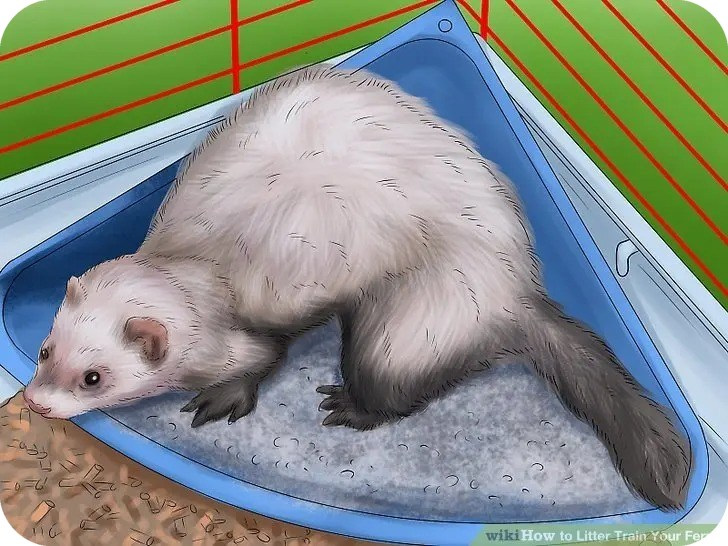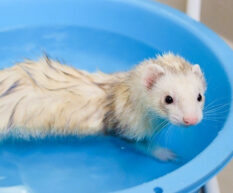Ferret News
Ferret Litter Training 101: A Beginner's Guide to Teaching Your Furry Friend Good Habits
By Jazmin "Sunny" Murphy

Litter training a ferret can be a challenging but rewarding task for ferret owners. Ferrets are intelligent and curious animals that can be trained to use a litter box just like a cat. With patience, consistency, and the right approach, you can successfully litter train your ferret and provide them with a clean and hygienic environment.
Here are six steps to help you litter train your ferret:
- Choose the right litter box and litter: Ferrets are small and agile, so it’s important to choose a litter box that is the appropriate size and shape for them. Look for a shallow litter box with low sides, as ferrets tend to kick litter out of traditional high-sided boxes. As for the litter itself, choose a brand that is specifically formulated for ferrets or cats. Avoid using clumping litter, as it can be harmful if ingested by ferrets.
- Place the litter box in a convenient location: Ferrets are creatures of habit and will be more likely to use the litter box if it is located in a familiar and convenient spot. Choose a location that is easily accessible to your ferret and away from their food and water dishes.
- Introduce your ferret to the litter box: Once you have set up the litter box, it’s time to introduce your ferret to it. Place your ferret in the litter box and gently encourage them to scratch and dig in the litter. If your ferret is hesitant to use the litter box at first, you can try placing a small amount of feces or urine from your ferret in the litter to encourage them to use it.
- Observe your ferret’s behavior: Pay attention to your ferret’s behavior and look for signs that they need to use the litter box. Ferrets tend to go to the bathroom after waking up from a nap, after eating, and after playing. When you notice your ferret exhibiting these behaviors, gently guide them to the litter box.
- Reward good behavior: Positive reinforcement can be a powerful tool when it comes to litter training your ferret. When your ferret uses the litter box successfully, be sure to reward them with treats, praise, and affection. This will help to reinforce the desired behavior and encourage your ferret to use the litter box in the future.
- Be patient and consistent: Litter training a ferret takes time and patience. It’s important to be consistent in your approach and to not get frustrated if your ferret doesn’t seem to be making progress. With consistent training and positive reinforcement, your ferret will eventually learn to use the litter box on their own.
In addition to the above steps, it’s important to keep the litter box clean and fresh to encourage your ferret to use it. Make sure to scoop out solid waste daily and completely empty and clean the litter box at least once a week.
Litter training your ferret not only helps to keep your home clean and hygienic, but it also provides your ferret with a sense of routine and structure. With patience, consistency, and the right approach, you can successfully litter train your ferret and provide them with a happy and contented environment.
Litter training a ferret requires patience and consistency, and there are a few mistakes that you should avoid in order to ensure the best results. Here are four things not to do when litter box training your ferret:
- Don’t use punishment: Ferrets are sensitive creatures and do not respond well to punishment or negative reinforcement. Yelling, hitting, or punishing your ferret for not using the litter box will only cause them to become anxious and fearful, and may make the litter training process more difficult. Instead, focus on positive reinforcement and reward your ferret for using the litter box.
- Don’t change the litter or litter box location frequently: Ferrets are creatures of habit and thrive on routine. If you constantly change the location or type of litter in the litter box, it may confuse and stress your ferret, making it more difficult for them to learn to use the litter box. Choose a litter and litter box that your ferret seems to be comfortable with and stick to it.
- Don’t use a litter box that is too small or too large: The size and shape of the litter box can make a big difference in your ferret’s willingness to use it. A litter box that is too small may be difficult for your ferret to maneuver in, while a litter box that is too large may be overwhelming or intimidating. Choose a litter box that is the appropriate size and shape for your ferret.
- Don’t ignore accidents: If your ferret has an accident outside of the litter box, it’s important to address the issue immediately. Clean up the mess and try to determine the cause of the accident. Was the litter box too dirty? Was it located in an inconvenient spot? By addressing the issue and making necessary adjustments, you can help prevent future accidents and encourage your ferret to use the litter box consistently.




